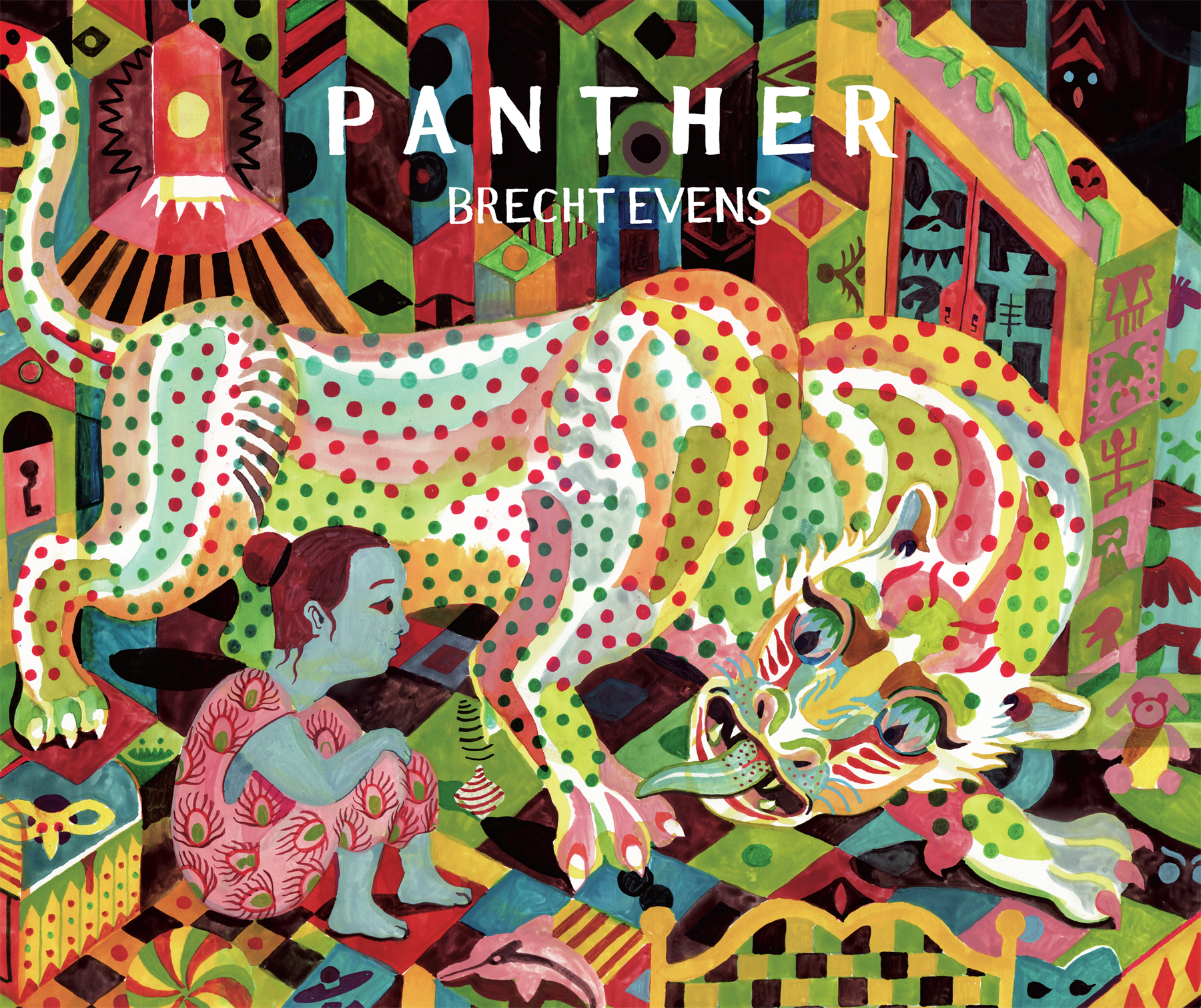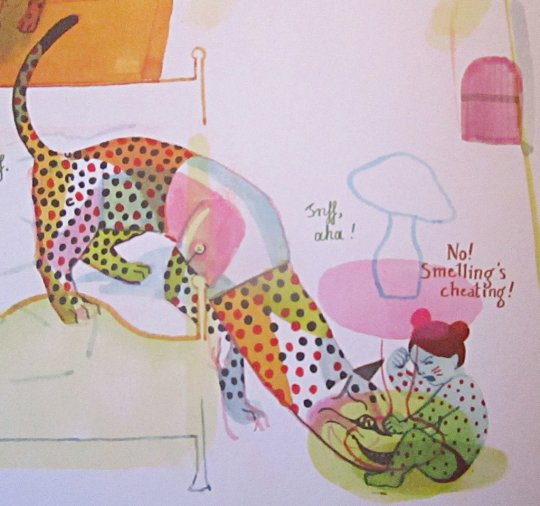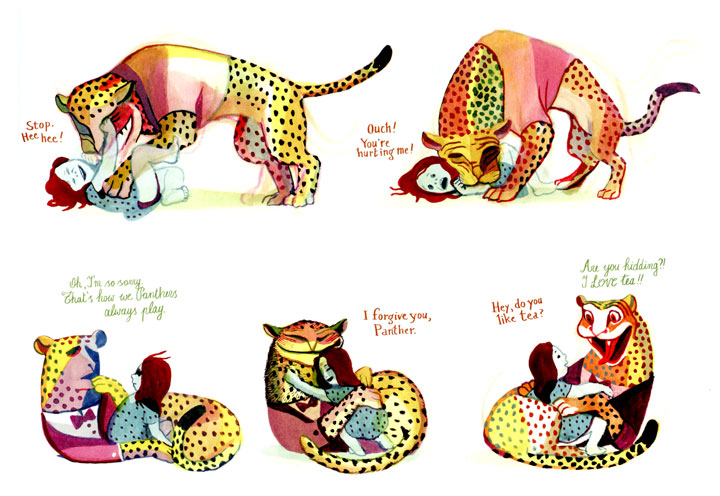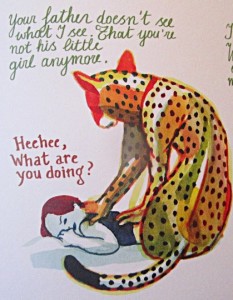The Underside of Imagination in Panther
Yesterday I finished reading Panther by Brecht Evens.
It’s an artsy graphic novel that can be read in about an hour — a deceptively short amount of time, considering how impossible it is to shake once you’ve read it.
In my exploration of the book, I’m going to give spoilers, so if you want to read it unspoiled (it will only take an hour, after all!), you should come back to this post later.

Panther begins when Christine’s cat dies. She is heartbroken; this is not her first traumatic loss. Later in the book, we learn that her mother “left” the family and may have committed suicide. Christine is a sad, lonely little girl living in a big house with her father who seems to be basically a good guy, but I’ll come back to that later.
 The night of her cat’s death, Panther emerges from Christine’s bottom drawer. He is shifty from the beginning, always changing his story and backtracking to make Christine happy. And she is mostly delighted with him. But the book’s sinister undertones are unsettling to the adult reader. In one image, Panther has his nose buried in Christine’s crotch, “sniffing” her out in a game of hide-and-seek. In another, he tells her she’s not “a little girl” anymore as he massages her back after trying to coax her to get the key to her room from her dad so she can have privacy. (This whole “key to the bedroom” thing kind of creeped me out all on its own. Why would you need a key to a child’s bedroom? Is she locked in at night?) Christine never discovers it, but Panther devours her stuffed dog, who had been attempting to warn her about him. When she notices the dog is gone, Panther replaces it with what basically an “evil twin” — a lookalike full of dangerous and unsettling suggestions for “games.” The night of Christine’s birthday party, the dog is the ringleader in a “game” that ends with the Pantherland gang stripping Christine down to her underwear while she cries and begs them to stop. Afterwards, Panther attempts to comfort her by urging her to snuggle up to him and “pet” him while he keeps her warm.
The night of her cat’s death, Panther emerges from Christine’s bottom drawer. He is shifty from the beginning, always changing his story and backtracking to make Christine happy. And she is mostly delighted with him. But the book’s sinister undertones are unsettling to the adult reader. In one image, Panther has his nose buried in Christine’s crotch, “sniffing” her out in a game of hide-and-seek. In another, he tells her she’s not “a little girl” anymore as he massages her back after trying to coax her to get the key to her room from her dad so she can have privacy. (This whole “key to the bedroom” thing kind of creeped me out all on its own. Why would you need a key to a child’s bedroom? Is she locked in at night?) Christine never discovers it, but Panther devours her stuffed dog, who had been attempting to warn her about him. When she notices the dog is gone, Panther replaces it with what basically an “evil twin” — a lookalike full of dangerous and unsettling suggestions for “games.” The night of Christine’s birthday party, the dog is the ringleader in a “game” that ends with the Pantherland gang stripping Christine down to her underwear while she cries and begs them to stop. Afterwards, Panther attempts to comfort her by urging her to snuggle up to him and “pet” him while he keeps her warm.
The book ends without “connecting the dots” of its troubling implications in any concrete way. What seems clear to me is that the book is grappling with the slippery connections between trauma, abuse, and imagination — but the lingering question is whether the potential creation/imagination of Panther was a coping mechanism for Christine to deal with real-life abuse, either past or present, or whether the entity of Panther itself was given too much power and ultimately became the abuser.

These are the possible interpretations that emerged for me upon first reading. (I had to return the book to the library, but I would not be surprised if additional meanings or interpretations emerged if I could spend more time with it.)
- Panther represents a psychotic break. Since we are given hints that Christine’s mother may have killed herself, a family history of mental illness seems plausible. Panther and his creepy friends may indeed be “all in Christine’s head,” with schizophrenia being the tidiest explanation, but they are real to Christine because she has no conscious control over them.
- Panther is an imaginary friend given too much power, and Christine creates trauma in her relationship with him as a way to banish him from her world.
 Panther is an imaginary friend that Christine creates to help her cope with or understand past or present abuse — most likely sexual abuse. Unable to understand the predation of a pedophile, Christine creates an actual predator to fill the abuser’s role. It could be that the trauma of her cat’s death awakened past traumas, or that the trauma is current and Christine is reinterpreting it as a coping mechanism. This is the interpretation I least want to be true, since the most likely candidate for current abuser is Christine’s father who, let’s not forget, is the only one with the key to her room. But I really want to believe she has someone safe in her life; if her father is also “Panther,” her outlook just feels far too hopeless.
Panther is an imaginary friend that Christine creates to help her cope with or understand past or present abuse — most likely sexual abuse. Unable to understand the predation of a pedophile, Christine creates an actual predator to fill the abuser’s role. It could be that the trauma of her cat’s death awakened past traumas, or that the trauma is current and Christine is reinterpreting it as a coping mechanism. This is the interpretation I least want to be true, since the most likely candidate for current abuser is Christine’s father who, let’s not forget, is the only one with the key to her room. But I really want to believe she has someone safe in her life; if her father is also “Panther,” her outlook just feels far too hopeless.- Panther is a real being who is visiting Christine from another world, preying on her vulnerability and innocence. All the abuse that unfolds after is really Panther’s abuse — but because of the strange quality of it, Christine will never be believed if she discloses it. Panther and his friends are off the hook no matter what happens with Christine next.
I couldn’t help but think of Tulpamancy as I read the book — because Tulpas are “real” and “separate” people to their creators, I don’t think I am the only one who harbors an insidious fear of what might happen if a Tulpa “goes bad,” bringing its host with it. In fact, Panther could be read as a cautionary tale of just that sort.
But it could also be read as a demonstration of the only thing some people have to fall back on when their real life is too hard to bear: imagination. And no matter how scary that gets, it’s still a safer place than reality.
Regardless of interpretation, Panther is one of the most haunting explorations of that line between fantasy and reality that I have ever read.